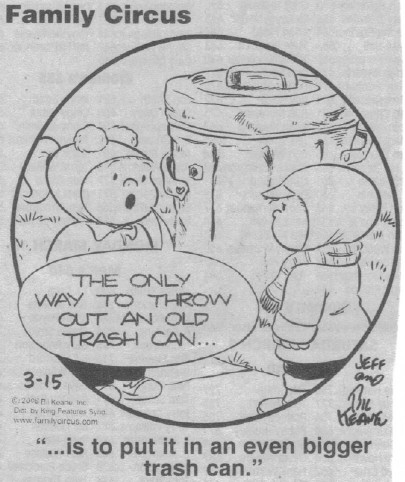John McCain like every other Republican in America wants to avoid what their 30 years of dereliction of duty has wraught. Nixon, Regan and Bush (my version of lions and tigers and bears, oh my!) all increased our dependence on oil and easy Chinese money. Bush in particular ushered us to the brink of a world depression. Grover Norquist, who wants to take us back to the 1930s is about to succeed:
http://www.pbs.org/now/transcript/transcript_norquist.html
BILL MOYERS: If states refuse to raise taxes to fix some of those problems we’ve just seen, that certainly won’t bother my next guest. He’s a sworn opponent of all taxes. He’s also the most powerful man in Washington not to hold a public office.
Officially, Grover Norquist heads an organization called Americans for Tax Reform where for almost 20 years now he has crusaded for lower taxes and less government. Unofficially he’s been the linchpin in Washington for the conservative revolution that now controls the government. His weekly meetings of activists became the politburo of strategy where all stripes of conservatives bear their differences in order to bury their hatchet in Democrats. From the Christian coalition to log cabin Republicans to the National Rifle Association on whose board he sits, this Harvard graduate keeps the troops on mission and on message. His success prompted Senator Hillary Clinton to muse aloud, if only Democrats had a Grover Norquist. Welcome to NOW.
GROVER NORQUIST: Glad to be with you.
BILL MOYERS: Well, you do have it all. You have the White House, the Congress, the regulatory agencies, the courts more or less. The last time Democrats, liberal Democrats, held that kind of power, they made some mistakes like the war in Vietnam that they couldn’t sustain the support of at home, emphasized parochial interests at the expense of the sort of bedrock universal values of American society. What are the errors you think conservatives running everything could make?
GROVER NORQUIST: I think it’s very important to always make sure that you’re talking to the entire coalition and to as many Americans as possible; not to go chasing after one little group or another. The Democrats would bring new groups into their party and not notice that larger groups are going out the back door. And so what I try and do whenever I work on an issue or work with political leaders is make sure that when you’re talking about a new approach, how does that…how does the entire coalition view that new approach? Is there a better or different way to do it that irritates fewer people and that satisfies a larger constituency?
BILL MOYERS: And that’s what you did at your Wednesday morning meetings? Those meetings became famous, for all kinds of conservatives being in there hammering things out.
GROVER NORQUIST: And we now have 27 versions of that at the state capital level, including one in New York City. So we’re taking the model of the “leave us alone” coalition from the national level to the state level as well.
BILL MOYERS: “Leave us alone?”
GROVER NORQUIST: Um-hmm. Look, the center right coalition in American politics today is best understood as a coalition of groups and individuals that on the issue that brings them to politics what they want from the government is to be left alone. Taxpayers, don’t raise my taxes. Property owners, don’t restrict or limit my property. Home schoolers, let me educate my own kids. Gun owners, don’t restrict my Second Amendment rights. All communities of faith, Evangelical Christians, conservative Catholics, Mormons, Muslims, Orthodox Jews, people want to practice their own religion and be left alone to raise their own kids.
BILL MOYERS: Do you have any sympathy for those states we just saw a few moments ago? Under the president’s plan, those states do not expect any direct aid from Uncle Sam. Do you have any advice for them?
GROVER NORQUIST: Sure, two things. The most important thing for President Bush and the federal government to do is to create a pro-growth economic policy because its economic growth that brings in more revenue for states and local governments. At the state level what they really have to do is take a long run view and limit the growth of spending, put limits on how much you spend. And then California, the state owns a whole bunch of land and other things that it could sell off it doesn’t need, and it needs to figure out which of those government jobs need to be in government, and what can be privatized or contracted out.
BILL MOYERS: You’re on record as saying, my goal is to cut government in half in 25 years, to get it down to the size where we can drown it in the bath tub. Is that a true statement?
And the Holy Satanic trilogy of George Mason University, Southern Methodist University and the University of Chicago have supplied all the intellectual fire power. SMU is where George Bush, jr. will try to lock up his presidential papers and avoid jail,
:}
Oh but I digress…One of the finest posters at The Oil Drum JoulesBurn who Blogs at:
http://satelliteoerthedesert.blogspot.com/
Had this little cutey today:
http://www.theoildrum.com/node/3855#more
McCain’s Gas Pains: Gas “Tax Holidays” A Good Idea?
Posted by JoulesBurn on April 15, 2008 – 7:45pm
Topic: Policy/Politics
Tags: gas prices, John McCain, politics (list all tags)
For immediate release from John McCain’s campaign:
John McCain, who just hours earlier proposed a “tax holiday” in which the 18 cent federal tax on gasoline would be suspended during the summer driving season, has reconsidered and has instead proposed that the U.S. gallon be redefined to be equal in volume to the current U.S. quart. “This will immediately lower the price at the pump by 75%, providing visible relief to millions of Americans”, quipped McCain. “I rejected the idea of setting it equal to the liter, for obvious reasons”.When questioners suggested that this move wouldn’t actually change how much consumers spend to fill their tanks, McCain responded “Well, neither would my previous proposal”.
In unrelated election news, the McCain campaign announced that P.T. Barnum has been posthumously appointed as their policy director. Also, Hillary Clinton has proposed a suspension of the law of gravity, at least during the summer flying season, to help the beleaguered airline industry. Barack Obama reportedly had no comment on these suggestions, other than to say that Americans are definitely “atwitter” about gas prices.
We interrupt this vacation from reality with the following observations…(under the fold…)
- As gasoline is a commodity for which prices are determined by supply and demand, lowering the price without increasing the supply will likely increase demand (usage). Prices will rise again to compensate.
- The 18.4 cents per gallon that is now flowing into the US treasury, and which is then spent building roads, bridges, and mass transit, will instead flow to oil companies — particularly those in foreign countries, since the US imports over half of its oil.
- Targeting the current gasoline tax instead for the development of alternative transportation and ways of using energy more efficiently will provide more lasting solutions to the current energy and economic crises than short-term attempts to fix the problem.




 Located about 40 miles northwest of
Located about 40 miles northwest of 











